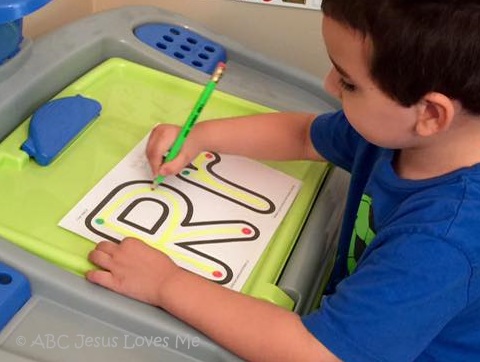
image by kira
After the child masters tracing the basic lines and circles, he or she is ready to begin Step #2.
There are multiple portions to this step with the Handwriting Curriculum and Preschool Curriculum focuses on different ones.
Most 3-year-olds do not have the fine and gross motor skills and development required to hold a pencil and successfully complete handwriting activities. Thus Step #2 focuses on learning the formation of the letters and numbers through tracing and art with the following aids:
1. Start/Stop Guides (Green/Red Dots)
2. Yellow Guides
3. Letter Chants
4. Number Rhymes
5. Tree Writing Guide
To begin a foundation of pre-reading, fun activities with Letter Posters are provided to teach the key phonic sound each letter makes.
Tracing a letter or number provide a multi-sensory way for the child to learn letters and numbers without the added stress of correctly holding a pencil.
- Sight: the child sees the letter
- Touch: the child forms the letter with his index finger
- Hear: the child says the letter or number chant/rhyme while tracing it
All numbers and letters are formed from top to bottom, left to right, and counter clockwise. Green dots are placed on the letters to begin, with the red dot denoting the child stop. The broad yellow line acts as a guide.
Begin by gently taking the child's hand in your hand. With her index finger extended, begin on the green dot and travel the yellow line to the red dot. Just as with the Pre-Writing Worksheets, as the child traces the yellow say "Gooooooooooo....Stop" as the child moves to the red dot.
When ready, say the letter rhyme while traveling the letter's path.

These unique guides can be used as introductions to letter formation. Use the tree to differentiate letters that live in the leaves, tree trunk, or the roots.
Color-lines also help in the formation. The middle line is green since many lowercase letters start (go) on the middle line and end on the bottom (red) line. The top line is blue (sky). Provided on each guide are the Letter Rhymes.
The worksheets are created to be separated and may be turned into tactile letters with glitter glue placed on the yellow lines (see below).

Tactile numbers and letters (also called sandpaper or textured) are a wonderful tool for a child learning to form letters and numbers. Using the roughness of sand, glitter, or yarn adds one more aspect of learning. As the child traces the tactile numbers and letters, be sure to say the Number Rhyme and Letter Formation Chants. This helps the child learn the correct formation.
Learn more...

Letter Posters provide an ample amount of learning opportunities for the child.
Tactile Letter: Assist the child is tracing the letters with his index finger. Green (start) and red (stop) dots may be added to the posters. Always say the Letter Formation Chants while tracing and be sure to correctly trace each letter.
Play Dough Letter: A tactile way to teach the child the formation of each number is to create play dough letters on the Letters Posters. Teach the child to roll the play dough in long snakes and use the poster underneath to form the number or letter. If the play dough sticks to the worksheet, place it in a plastic protector.
Pre-Reading Art: Hang the Poster on a vertical surface and decorate with items that begin with the phonetic sound of the letter. For example, on Letter Aa place farm animal stickers. Focus on the /a/ sound of “animals” during this activity. The curricula provide fun ideas for each letter.
Buy Now Handwriting Curriculum
Buy Now 3 Year Workbook

After the preparatory activities of Weeks 1- 24 of the 3 Year Curriculum, some 3.5 year-old children are ready to write their names with broken crayons or short pencils.
To see if a child is ready, give the child the first letter of her name to trace with her finger. If the letter is correctly formed, it may be time to move to the next step.
Using the first letter in the child's name, provide the child with the 3" letter from the 3" Uppercase Letter Worksheet. Giving the child a broken crayon, assist the child in saying the Letter Formation Chant and writing the 1st letter in her name multiple times. Using the letter repeatedly, rainbow write with different colored crayons.
The Lowercase, Uppercase, and Numbers Worksheets may also be turned into tactile letters/numbers with glitter glue placed on the yellow lines (see above). The 3" size also make for a fantastic tradition between Steps #2 and #3 of the handwriting process.
If the child is unable to correctly trace the letter, continue practicing tracing activities before writing. Moving on will only frustrate everyone, develop bad habits, and cause negative association with writing.